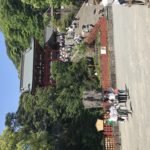
Stairs to central prayer area
I shuffle through the crowd to the front and step into the first open space I see. Water bubbles over the stone fountain, the sound accompanied by people spitting all around me. I try to remember what I’m supposed to do next. Maybe just a peek at the woman next to me…oh yes, now I remember.
I grasp the long wooden handle with my left hand and dip the tin cup into the water. I pour water over my right hand. Switching the handle to my wet right hand, I then pour water over my left hand, being careful to reserve enough for my mouth. Both hands wet, check.
Uh-oh. I don’t want to put the tin cup to my lips. I’m all for diving into a culture, but even as an underage kid sanctioned to drink wine at mass on Sunday, I skipped the community goblet.
Quick peek at the man next to me (several people have come and gone while I’ve been fumbling). Of course! Pour the water into your hand, then slurp. I tip the cup over my left hand and miss. Yes, I miss my hand entirely. The handle is half a meter long and I’m wielding it with my nondominant hand. I peer into the cup. Thank the gods it’s not empty. This time my aim is better, and I quickly bend my head and slurp.
As the water swishes I realize I am really, really, thirsty. Everything in me wants to swallow this bit of water that tastes very much like the stuff I drank out of the hose as a kid. I force myself to spit it into the narrow stone gutter separating me from the rest of the water. Not one for spitting, I dribble water all down my front.
“Don’t you feel purified?” the tour guide asks when I return to the group. She is my grandmother’s doppelgänger. If my grandmother were Japanese.
“Hei, absolutely.”
She slips me a handkerchief and I dab my shirt.
I do much better at the actual shrine. I toss my money into the trough – that was the hard part; Shinto gods are not inclined to grant wishes from those with terrible aim (although I could then wish for better aim and they would see how seriously I needed it) – bow twice, clap twice, pray, and bow again. Mission accomplished.
But when I meet up with my tour guide outside the central prayer area, I see a cart with hundreds of white slips of paper tied to its vertical wire cage.
My guide notices. “Those are bad fortunes.”
“Fortunes?” I thought fortunes were for cookies. I just cleansed, purified, bowed, and prayed. All with utmost reverence for a religion as old as Japan itself.
“Japanese are not so serious. After all, who doesn’t like to know their near future. It’s fun. After you pray, you can pay to pick a number.”
My eyebrows raise and she laughs.
“You give the number to those pretty ladies and they give you your fortune. Good fortune? Take home. Bad fortune? Tie over there and give back to the Gods.”
No kidding. I look at the ladies behind the counter doling out paper fortunes. They are very pretty.
“More serious than fortune cookie, but not so serious as prayer.”
I turn again and marvel at this 850 year old, world famous shrine. I try to imagine a booth of pretty women handing out penny-fortunes at the back of the Catholic church I attended decades ago. Father Falk was all for cutting mass a few minutes short to watch the Packers. But this? I don’t think so.
Personally, I think it’s wonderful. People are just people. Japanese do not seem to strive to be perfect; they strive to be balanced.
I think I’ll send a suggestion letter to my old church. Anonymously.

You are making me wish I didn’t hate flying as much as I do!